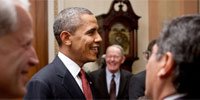In This Episode << SLIDE LEFT TO SEE ADDITIONAL SEGMENTS
Soldier Dead
Read an excerpt adapted from Michael Sledge’s book SOLDIER DEAD: HOW WE RECOVER, IDENTIFY, BURY, AND HONOR OUR MILITARY FALLEN (Columbia University Press, 2005):
Burying military dead with honors is not a recent practice. Thucydides’ account of the funerary rites of warriors who died in the Peloponnesian War reads as though it could have appeared in The New York Times:
“In the same winter the Athenians gave a funeral at the public cost to those who had fallen in this war. It was a custom of their ancestors, and the manner of it is as follows. Three days before the ceremony, the bones of the dead are laid out in a tent which has been erected; and their friends bring to their relatives such offerings as they please. In the funeral procession cypress coffins are borne in cars, one for each tribe, the bones of the deceased being placed in the coffin of their tribe. Among these is carried an empty bier decked for the missing, that is, for those whose bodies could not be recovered. Any citizen or stranger who pleases joins in the procession, and the female relatives are there to wail at the burial. The dead are laid in the public sepulcher in the most beautiful suburb of the city, in which those who fall in war are always buried; with the exception of those slain at Marathon, who for their singular and extraordinary valor were interred on the spot where they fell. After the bodies have been laid in the earth, a man chosen by the state…pronounces over them an appropriate panegyric…Pericles, son of Xanthippus, was chosen to pronounce their eulogium.”
Apparently, the Greeks had less trepidation about seeing the bones of their slain warriors than we do today; it would be hard to imagine the bones of unidentified Soldier Dead “laid out in a tent” for all to honor. Of course, the Greeks did what their technology allowed them to do; our level of advancement provides us with different choices.
The public is called to honor the fallen. Theodore Roosevelt, in a 1907 Arlington National Cemetery dedication to the dead of his regiment, said “a few had the ‘supreme good fortune of dying honorably on a well-fought field for their country’s flag.'” During World War I and World War II, two of Roosevelt’s own sons had this “good fortune” and another, Kermit, killed himself while stationed at a military base. Ultimately, the final resting place for fallen military is but a marker of our debt to them and their families. No ceremony can do much to assuage the loss borne by the living.
“But in a larger sense, we cannot dedicate, we cannot consecrate, we cannot hallow this ground. The brave men, living and dead, who struggled here have consecrated it far above our power to add or detract.”
Abraham Lincoln’s words are as meaningful now as they were when spoken in the Gettysburg Address. There is no “fixing” the bereaved of someone killed in service. There is only the offering of some form of recognition of their sacrifice, as reflected in the words of Pericles speaking to those who gathered at a public funeral for Peloponnesian dead: “Comfort, therefore, not condolence, is what I have to offer to the parents of the dead who may be here.”
I have toured several great military cemeteries – Arlington National Cemetery, of course, but also Verdun, Punchbowl in Hawaii, Normandy, and the U.S. Soldiers’ and Airmen’s Home National Cemetery in Washington, D.C. Some of these locations are frequently visited, some are more solitary, and each has its own special spirit.
At Arlington, the changing of the guard at the Tomb of the Unknowns silences the crowds. I looked at the faces of the people watching the solemn ritual and tried to fathom what they were thinking, what they knew about what they were seeing. I alternated between wanting to gather them around and tell them a story, much as a worn and weathered traveler would share his experiences with his friends during a slow evening by a warm fire, and, on the other hand, wanting to get a megaphone and bellow out that what they were witnessing was not even the beginning of the beginning of a story. I wandered up and down the hills and through the lanes where few others ventured, and even those who did usually rode the tour shuttle. Arlington is a wonderful cemetery, but my real sense of the dead came more strongly to me at other burial grounds.
At the Punchbowl in Honolulu, doves filled the hollowed-out basin with a diminutive and plaintive cry. A single bird might not be noticed, but the sounds of hundreds joined together in an unorchestrated chorus that formed a soundtrack for the visual beauty of the cemetery. I came across an elderly man with a small electric grass cutter in his hand; he was kneeling by a grave and slowly, carefully trimming the already well-tended grass around a grave. I wanted to ask him who was buried there, but left him alone with his thoughts and memories.
The U.S. Soldiers’ and Airmen’s Home National Cemetery is like an old veteran: he doesn’t stand as straight as he used to, but he still stands tall under the spreading branches of the trees that shade the graves.
The Verdun cemetery is located in rolling farmland that also houses French, German, and English cemeteries. The words from the song, “where have all the soldiers gone?,” seem to float through the hills and valleys, wrapping its themes and lines around the multitudinous rows of crosses. There are so many dead soldiers. When I tried to contemplate the grief of the family members, I found myself incapable of doing so, stymied, as though I were trying to understand the theory of relativity. I walked among the hoar-covered marble tombstones and found myself viewing the cemetery as a single unit instead of as individual graves, much like single soldiers are lost in a division of troops standing in formation.
Verdun is old history. To a certain extent, I can distance myself from World War I with its millions of dead. But Normandy has the names of men who might still have been alive, had they not been killed in action. I stood in the cemetery on a cold February day, one of few visitors, and as I walked between the tombstones the names of the dead kept coming up before my eyes. The thought that for every grave I was looking at there were two others back in the States made me even more aware of the price paid in World War II. And to top it off, I was looking at just one cemetery of one country.
Memorial Day 1920 was a pivotal event in the healing process following World War I. Prior to that time, the aftermath of the monumental struggle consisted of rebuilding infrastructure and just “getting by.” The Graves Registration Service (GRS) planned and coordinated the ceremonies in every European country where American Soldier Dead had been buried; every grave was decorated with a flag, and cemeteries were adorned with flowers and wreaths. Clergy presided over the solemn ceremonies. In England, similar care was given to the 108 cemeteries containing American dead. Colonel Rethers of the GRS “issued orders that civilian employees be sent to every locality to purchase flowers, which they placed, together with a flag, upon every grave.”
And when it came to the expression of feelings, quartermaster personnel penned the following:
“As for the spirit of the French people on this occasion, it is almost impossible to draw a picture that would convey the desired impression of their friendly attitude and of their pathetic and most touching expression of respect for our dead. While the American people have undoubtedly a very genuine sentiment regarding the more sacred and emotional phases of life, they not infrequently lack the power of expressing their real feelings, or they are prevented from the same by a hesitancy to appear, as they think, sentimental. But the French people have no such scruples. They feel deeply and have a trained ability of expression.”
Now, Memorial Day is a commercialized event, and the papers devote much more space to advertising than to the memories of those whose deaths make such ads possible. It seems that there is no matter of the heart or spirit that is beyond trespass for the purpose of making a buck, and I am ashamed for our country when May rolls around. For my part, I celebrate Memorial Day on its original date, May 30, and resist the urge to take advantage of a three-day weekend with the “new and improved” date of the fourth Monday in May.
It was while wandering through the many graves overseas, away from noise and distracting thoughts that I began to really sense the dead. They spoke in a soft, almost undetectable manner, like gentle ocean swells that pass beneath a vessel at sea. Among the white markers I realized that we no longer have a post-death national commemoration of fallen soldiers. We have lost a singular, commemorative, and group remembrance. We have the overseas cemeteries for World Wars I and II. For Korea, we have the hundreds of unknowns buried at the Punchbowl, all in one section, and thus have a sense of the group participation and ensuing death. The Vietnam Wall memorial is an excellent substitute for a common cemetery because it provides, in one place, a visual image of the dead. But what do we have for the Gulf War and Iraq? We struggle to find something that adequately serves as a reminder of the price of war.
Fortunately, there have been efforts to educate the public about the existence of Soldier Dead as a group rather than as lost individual lives scattered throughout America. The hundreds of pairs of combat boots that have recently been displayed in various cities around the country is one example, but it is far too ephemeral. Something else of a more permanent nature will eventually have to be designed and constructed for the dead of the Gulf War and the more recent war in Iraq, a fitting memorial for the fallen, or else we will continue to be haunted by the memories of those who died for us.
Michael Sledge is a freelance journalist and writer who has studied extensively the sociology and psychology of the behavior of military personnel. He lives in Shreveport, Louisiana.





